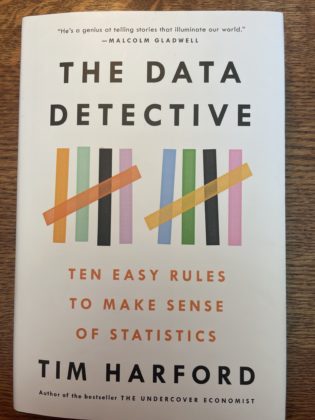The man sat next to me at lunch at the conference I attended last month in Florida. He is a reliability engineer. His professional life has a foundation built on numbers. He began talking about Covid and how he and his wife had both contracted a bad case of the virus. She took a medication recommended by few doctors. She did recover. I’m not talking about medicine here.
He quoted statistics from India to support their decision.
I was surprised. He has far more training in numbers than I, yet he quoted statistics that had a spurious rigor. If he used numbers like that in his plant, some very expensive equipment would be broken.
We all get suckered in by statistics that are incomplete or misleading. And we all can miss those numbers that tell us something important. We should stop and consider when we see numbers thrown around in the news or across the dining table.

Soon after my conversation, I ran across The Data Detective: Ten Easy Rules to Make Sense of Statistics by Tim Harford. This book does not require a background in math. It is readable. Packed with stories about people who famously got the numbers wrong and those who got them right. This book will help you not be fooled by every number you see flashed at you.
I suppose I should hint at the ten rules.
- Stop and notice our emotional reactions
- Combine the “bird’s eye” statistical perspective with the “worm’s-eye” view from personal experience
- Look at labels on the data, do we understand what’s really described
- Look for comparisons and context
- Look behind the statistics at where they come from
- Ask what is missing
- Ask tough questions about algorithms and the big datasets
- Pay more attention to the bedrock of official statistics
- Look under the surface of any beautiful chart or graph
- Keep an open mind
And finally, Harford’s “golden rule”—a good trait to develop for life in general—Be curious.






Trackbacks/Pingbacks